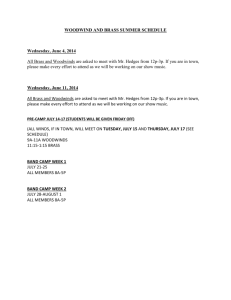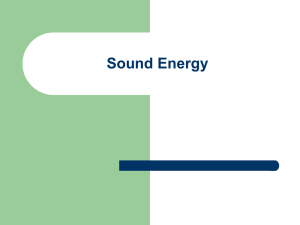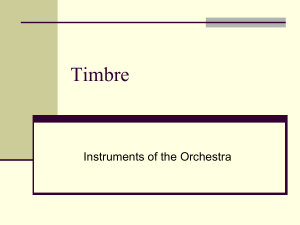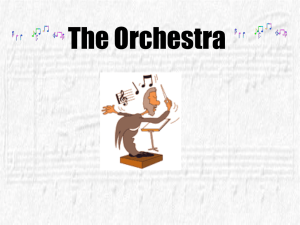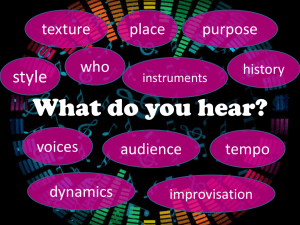The Structure of “Pictures at an Exhibition”
advertisement
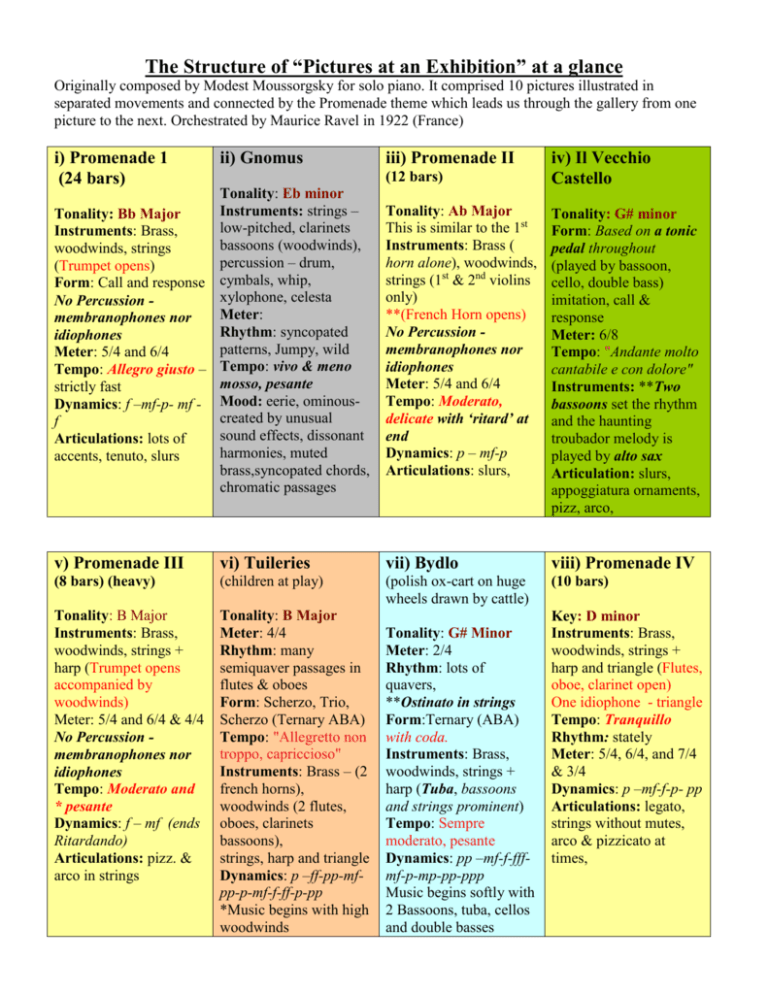
The Structure of “Pictures at an Exhibition” at a glance Originally composed by Modest Moussorgsky for solo piano. It comprised 10 pictures illustrated in separated movements and connected by the Promenade theme which leads us through the gallery from one picture to the next. Orchestrated by Maurice Ravel in 1922 (France) i) Promenade 1 (24 bars) ii) Gnomus iii) Promenade II (12 bars) iv) Il Vecchio Castello Tonality: Eb minor Instruments: strings – Tonality: Bb Major low-pitched, clarinets Instruments: Brass, bassoons (woodwinds), woodwinds, strings percussion – drum, (Trumpet opens) Form: Call and response cymbals, whip, xylophone, celesta No Percussion Meter: membranophones nor Rhythm: syncopated idiophones patterns, Jumpy, wild Meter: 5/4 and 6/4 Tempo: Allegro giusto – Tempo: vivo & meno mosso, pesante strictly fast Dynamics: f –mf-p- mf - Mood: eerie, ominouscreated by unusual f sound effects, dissonant Articulations: lots of harmonies, muted accents, tenuto, slurs brass,syncopated chords, chromatic passages Tonality: Ab Major This is similar to the 1st Instruments: Brass ( horn alone), woodwinds, strings (1st & 2nd violins only) **(French Horn opens) No Percussion membranophones nor idiophones Meter: 5/4 and 6/4 Tempo: Moderato, delicate with ‘ritard’ at end Dynamics: p – mf-p Articulations: slurs, Tonality: G# minor Form: Based on a tonic pedal throughout (played by bassoon, cello, double bass) imitation, call & response Meter: 6/8 Tempo: "Andante molto cantabile e con dolore" Instruments: **Two bassoons set the rhythm and the haunting troubador melody is played by alto sax Articulation: slurs, appoggiatura ornaments, pizz, arco, v) Promenade III vi) Tuileries vii) Bydlo viii) Promenade IV (8 bars) (heavy) (children at play) (polish ox-cart on huge wheels drawn by cattle) (10 bars) Tonality: B Major Instruments: Brass, woodwinds, strings + harp (Trumpet opens accompanied by woodwinds) Meter: 5/4 and 6/4 & 4/4 No Percussion membranophones nor idiophones Tempo: Moderato and * pesante Dynamics: f – mf (ends Ritardando) Articulations: pizz. & arco in strings Tonality: B Major Meter: 4/4 Rhythm: many semiquaver passages in flutes & oboes Form: Scherzo, Trio, Scherzo (Ternary ABA) Tempo: "Allegretto non troppo, capriccioso" Instruments: Brass – (2 french horns), woodwinds (2 flutes, oboes, clarinets bassoons), strings, harp and triangle Dynamics: p –ff-pp-mfpp-p-mf-f-ff-p-pp *Music begins with high woodwinds Tonality: G# Minor Meter: 2/4 Rhythm: lots of quavers, **Ostinato in strings Form:Ternary (ABA) with coda. Instruments: Brass, woodwinds, strings + harp (Tuba, bassoons and strings prominent) Tempo: Sempre moderato, pesante Dynamics: pp –mf-f-fffmf-p-mp-pp-ppp Music begins softly with 2 Bassoons, tuba, cellos and double basses Key: D minor Instruments: Brass, woodwinds, strings + harp and triangle (Flutes, oboe, clarinet open) One idiophone - triangle Tempo: Tranquillo Rhythm: stately Meter: 5/4, 6/4, and 7/4 & 3/4 Dynamics: p –mf-f-p- pp Articulations: legato, strings without mutes, arco & pizzicato at times, Articulations: staccato Articulation: tenuto ix) Ballet des Poussins dans leurs coques Tonality: F Major Meter: 2/4 Form: Scherzino (mini scherzo and trio), Ternary (ABA). Has a trio section with predominately chromatic harmony. Ends with a Coda Rhythm: syncopated pecking chords with acciaccaturas which give the impression of tiny pecking at the egg-shells in the flute and oboe passages, lots of quavers and rests, chromatic scale runs, cluster chords Instruments: Articulations: trills in violin and clarinet passages, pizz., high staccato notes in woodwind Dynamics: pp – mp-mf-pp N.B there is also a tonic pedal used in this piece. Some Points to note 1. Basis for the work: A desire by Modest Mussorgsky to translate the visual images of Hartmann’s exhibition into aural pictures. A desire to pay tribute in sound to his deceased friend. 2. Features of the orchestration that is typical of the period: Romantic Era – Scoring for large orchestra, inclusion of non-traditional orchestral instruments (celesta, whip or rattle, and saxophone), wide dynamic changes – (ppp – fff). Harp was also new. 3. How the opening Promenade differs from the others: brassy timbre, faster tempo, thick texture, heavily accented opening, the key, the length – it’s the longest promenade 4. To determine the title of an extract – (i) Observe the Time signature (ii) the Key signature and (iii) observe the notes used to help you recall the tune. 5. Era of Work: Romantic period (1825 – 1900) The Romantic period was ushered in by artists who expressed themselves freely and personally. There was a strong desire to release emotion and achieve freedom in the music. New music forms emerged: i) the art song, (lied) which combined Romantic poetry with voice and piano; ii) stylised piano music such as the waltz, mazurka, polonaise, and etude (study piece); iii) piano music in free form such as the fantasy, arabesque, rhapsody, romanza, ballade and nocturne; and iv) symphonic works such as the tone poem (descriptive piece). Programmatic content was expressed in tone poems by Liszt and others, and in symphonic works such as Berlioz’s Symphony Fantastique, and in piano music such as Mussorgsky’s Pictures at an Exhibition (later orchestrated by Maurice Ravel in 1923). v) Nationalism is prevalent in works like Chopin’s polonaises and mazurkas. Other examples are Liszt’s Hungarian Rhapsodies, Smetana’s The Bartered Bride and The Moldau, Borodin’s Prince Igor and Rimsky-Korsakov’s Scheherezade. vi) The music of the Romantic period mostly contained warm, personal melodies; expressive indications (espressivo, dolce, con amore, con fuoco,) implied interpretive freedom (rubato) and harmonic colour (new chords such as the ninth) Colour was intensified by improvements in instruments, particularly the piano. 6. Some features of the music include the following: MELODY: Long, lyrical melodies with irregular phrases; Wide, somewhat angular skips; extensive use of chromaticism; vivid contrasts; a variety of melodic ideas within one movement. RHYTHM: Frequent changes in both tempo and time signatures. TEXTURE: Almost entirely homophonic. TIMBRE: A great variety of tone colour; woodwind and brass sections of the orchestra increased; many special orchestral effects introduced; rich and colourful orchestration. Tuba added to the brass family. Valves were invented, giving the brass more flexibility. Composers wrote for woodwind instruments in threes of even fours. The piccolo, cor anglais, bass clarinet and double bassoon were added. More varied percussion (e.g. bongos, whip, timpanis) were added. A larger range of pitch and volume was now possible. New combinations of instruments were brought about 7. PROGRAMME MUSIC As links were formed between music, painting and literature, composers started to compose programme music. - music that tells a story. (The opposite is absolute music - music without a story.) There are three main types of programme music for orchestra: 1. The Programme Symphony - e.g. Beethoven's Pastoral Symphony, The Symphonic Fantastique (About a young man who is in love. He dreams about her, and she becomes a melody in his mind. This melody is an 'idée fixe', it keeps coming round again, a recurring theme. It is by Berlioz,) 2. The Concert Overture - It is a one movement programme piece for orchestra, intended for performance at a concert. E.g. Fingal's Cave by Mendelssohn, Tchaikovsky's 1812 Overture, Romeo and Juliet. 3. The Symphonic Poem (the Tone Poem) - was invented by Liszt. It is a one movement programme piece for orchestra. Liszt used a device called thematic transformation (a basic theme that is continually being changed in mood and character, like the 'idée fixe'). Liszt wrote a thematic piece called Hamlet. Other examples are: Danse Macabre (by Saint-Saëns), Vltava (by Smetana), A Night on the Bare Mountain (by Mussorgsky), The Sorcerer's Apprentice (by Dukas. 4. Incidental Music : It is music specially composed to be heard at certain points during the performance of a play. (To set the mood, to cover the scenery changed or as background music) 8. The Main Characteristics of Romantic Music 1. 2. 3. 4. 5. 6. 7. 8. 9. Freedom of form and design. It was more personal and emotional. Song-like melodies (lyrical), as well as many chromatic harmonies and discords. Dramatic contrasts of dynamics and pitch. Big orchestras, due mainly to brass and the invention of the valve. Wide variety of pieces (i.e. songs up to five hour Wagner operas) Programme music (music that tells a story) Shape was brought to work through the use of recurring themes. Great technical virtuosity. Nationalism (a reaction against German influence) Sourced from http://www.rpfuller.com/gcse/music/romantic.html

